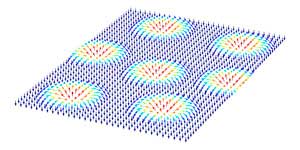| Posted: Nov 01, 2017 |
Unlocking the potential of magnetic skyrmions
(Nanowerk News) Magnetic skyrmions offer the promise of next-generation memory and computing technologies, such as cache memory devices and cloud computing. Now A*STAR researchers have developed an innovative technique for making tunable skyrmions that could help unlock their potential (Nature Materials, "Tunable room-temperature magnetic skyrmions in Ir/Fe/Co/Pt multilayers").
|
 |
| Schematic array of magnetic skyrmions in a uniformly magnetized background. Arrows denote the orientation of magnetic spins forming the skyrmion structures. (Image: A*STAR Data Storage Institute)
|
|
Only recently discovered, skyrmions are tiny structures that are formed in magnetic materials and behave like nanoscale magnetic particles. This means they can self-organize into ordered arrays or lattices, and can be created, moved, and erased using electrical currents. To become a viable technology, however, requires the ability to modulate these properties and to achieve their electrical detection under ambient conditions.
|
|
This led Anjan Soumyanarayanan and colleagues from the A*STAR Data Storage Institute and Institute of High Performance Computing, in collaboration with Nanyang Technological University, Singapore and Lawrence Berkeley National Laboratory in the United States, to develop an innovative technique for making ultrathin films for hosting tunable skyrmions.
|
|
“Our initial goal was to understand skyrmion formation, establish their electrical detection, and control their physical properties,” explains Soumyanarayanan. “We are now examining skyrmions in nanoscale devices for their potential as bits in memory applications.”
|
|
By using a technique called magnetron sputtering — a process in which atoms are ejected from a source material and then deposited on to a substrate — the researchers fabricated an ultrathin film with sequential layers of iridium, iron, cobalt, and platinum on a silicon substrate.
|
|
Harnessing the large and opposite signs of the chiral magnetic interaction between the iridium-iron and cobalt-platinum interfaces, referred to as the Dzyaloshinskii-Moriya interaction, allowed the team to establish a platform for nanoscale-sized skyrmions. And by varying the thickness of the layers, the team was able to modulate the physical properties, such as the size, density, and stability of the skyrmions.
|
|
“The platform allows us to directly control the magnetic interactions that govern skyrmion properties by simply varying the thickness of the constituent layers, and provides skyrmion configurations tailored to the specific requirements of a range of different applications,” says Soumyanarayanan.
|
|
The work demonstrated, for the first time, the electrical detection of ambient skyrmions, and could lead to stable and highly scalable skyrmion-based memory and computing technologies, explained Soumyanarayanan. These could then be easily integrated into microchips using existing manufacturing processes commonly used in the electronics industry.
|
|
“Our next steps will be to stabilize the skyrmions in nanostructures at zero magnetic field, and to demonstrate their electrical reading and writing in electronic devices,” says Soumyanarayanan.
|

